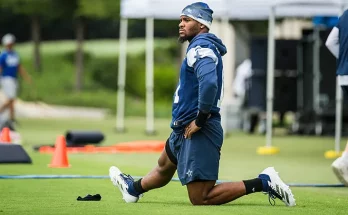Fans of the Boston Celtics are finding themselves in an unusual and perhaps conflicting emotional space as they watch former Celtics center Kristaps Porzingis take the floor with the Latvian National Team in the ongoing FIBA EuroBasket exhibition games. For many, Porzingis’ departure from Boston was bittersweet, marked by the hope that he could eventually find a role in the NBA that suited his unique skill set, and the disappointment of a tenure in Boston that never fully materialized into the consistent dominance many had expected. Now, seeing him in international play brings a mixture of admiration, nostalgia, and perhaps a twinge of “what could have been” as he showcases the abilities that once made him one of the most intriguing young players in the league.
Porzingis’ time with the Celtics was a story of potential, interrupted by injuries and inconsistency. Drafted originally by the New York Knicks in 2015 and quickly establishing himself as a dynamic, stretch-big with exceptional mobility and shooting range for his size, he was traded to the Dallas Mavericks and eventually made his way to Boston. Celtics fans had hoped that pairing Porzingis with the likes of Jayson Tatum and Jaylen Brown could form a versatile, modern frontcourt capable of blending shooting, rim protection, and floor spacing in a way that few teams in the NBA could replicate. Yet, the reality was more complicated. Porzingis’ stints in Boston were hampered by health concerns and the team’s own evolving roster needs, which meant that the full vision for how he might fit into Boston’s system was never fully realized.
Watching Porzingis now in international play with Latvia provides a stark contrast to his NBA experience, not necessarily because the level of competition is lower, but because the structure and style of international basketball may highlight different aspects of his game. European basketball, with its emphasis on ball movement, spacing, and tactical execution, often rewards skill sets that are sometimes underutilized in the NBA due to team fit or stylistic differences. Porzingis has always been a player whose skills translate exceptionally well in this environment—his ability to stretch the floor with deep shooting, protect the rim with his length, and move fluidly around the court are qualities that can be magnified when the offensive and defensive schemes are designed around his unique attributes. For Celtics fans who may have been frustrated by the limitations of his NBA usage, seeing him excel in this different context can evoke a mix of admiration and a little bittersweet nostalgia.
The EuroBasket exhibition games have provided ample opportunity for Porzingis to remind fans why he was once considered one of the most promising young big men in the world. His combination of size, skill, and agility makes him a difficult matchup in any setting, and international play seems to allow him to operate with more freedom than he sometimes had in Boston. The Latvian team, recognizing the talents he brings, appears to have built schemes that maximize his impact, often letting him initiate plays from the high post, use his shooting touch to stretch defenses, and employ his length to dominate in defensive scenarios. This has led to performances that are, in many ways, reminiscent of what Celtics fans hoped he might bring on a nightly basis in the NBA, creating a natural tension between pride in his accomplishments and the lingering sense of unfulfilled potential in his former professional environment.
Beyond the tactical considerations, there is an emotional component to witnessing Porzingis in this international setting. Fans often develop a bond with players not just for what they do on the court, but for the narrative arcs their careers take and the moments they share with their team. Porzingis’ journey has been one of highs and lows, trades and transitions, moments of brilliance and stretches of frustration. For Celtics supporters, watching him thrive on a different stage can rekindle memories of the hope and excitement that accompanied his arrival in Boston, while also serving as a reminder of what might have been had circumstances—injuries, team fit, or timing—been different. There is a complex interplay of respect for his skill, nostalgia for his time in Boston, and the natural human inclination to imagine alternative histories in sports.
Moreover, seeing Porzingis take on a leadership role with Latvia provides another layer of reflection for Celtics fans. In Boston, he was often viewed as a complementary piece within a roster that featured multiple star talents, which meant that his influence, while significant at times, was never the central story of the team. With Latvia, he steps into a position of prominence, carrying the responsibility of being a focal point for his national squad. His ability to assume this leadership mantle and deliver under pressure speaks to a level of maturity and development that may not have been fully apparent during his NBA tenure. For Celtics fans, this can be inspiring, showing that the player they once cheered for is growing and adapting, even if it’s outside the Boston spotlight.
Another factor contributing to the mixed emotions is the way international play emphasizes different aspects of basketball intelligence and skill. Porzingis has always been a cerebral player, capable of reading defenses, moving strategically without the ball, and understanding spacing and angles in a sophisticated way. In FIBA competition, where the game can be more structured and less reliant on sheer athleticism than the NBA, these qualities become even more visible. Celtics fans observing this might feel a renewed appreciation for his talents, recognizing that the elements that made him a high-ceiling prospect are still very much present, and perhaps even more pronounced in this environment than they ever were during his time in Boston. There is a bittersweet acknowledgment here: the player they hoped would flourish on the NBA stage is flourishing, just not in the context they originally envisioned.
The emotional complexity is heightened when considering the context of Porzingis’ departure from the Celtics. His move to other teams, whether through trade or free agency, left some fans with unresolved feelings—gratitude for what he contributed, disappointment in what didn’t materialize, and curiosity about how he would fare in new settings. The FIBA exhibition games function as a kind of window into that ongoing story, offering glimpses of the player he is becoming while inevitably provoking reflections on the player he might have been in Boston. For some fans, these games are a source of joy and inspiration; for others, they are a reminder of what was lost or never fully realized. The duality of pride and wistfulness is a natural response when watching a talented former player excel elsewhere.
It’s also worth noting that international basketball tends to foster a different type of fan engagement and perception. Performances in events like EuroBasket can elevate a player’s stature on a global scale, sometimes redefining their legacy in ways that NBA-focused narratives do not capture. For Celtics fans, seeing Porzingis receive recognition and admiration on this stage might spark a reevaluation of his career—not just what he did or didn’t do in Boston, but the broader arc of his development as a player and a competitor. There is an opportunity to appreciate his journey in a more holistic sense, understanding that basketball success and fulfillment can manifest in multiple contexts, not solely within the NBA.
Additionally, these exhibition games serve as a reminder of the transient nature of professional sports careers. Players move, teams change, and circumstances evolve in ways that are often beyond any individual’s control. For Celtics fans, Porzingis’ current success is a testament to the resilience and adaptability that athletes must possess, even when their tenure with a particular team does not unfold as hoped. It underscores the idea that a player’s story does not end with a single franchise or season, and that growth, reinvention, and achievement can occur in unexpected places. This perspective can help reconcile the conflicting emotions of pride and nostalgia, allowing fans to celebrate his accomplishments while acknowledging the past.
Another layer to consider is the stylistic contrast between Porzingis’ role in Boston and his current role with Latvia. In the NBA, he was often asked to fit within a system that emphasized certain defensive schemes, rotations, and shared offensive responsibilities. At times, this limited his ability to showcase the full range of his talents consistently. With Latvia, however, the game plan often revolves around him, affording him more touches, more decision-making freedom, and greater opportunity to influence outcomes. Celtics fans observing this may recognize that the difference is not merely about skill level, but about context and opportunity—the conditions under which a player’s abilities are maximized. This realization can bring both satisfaction in seeing him thrive and a twinge of regret that such conditions were not fully present in Boston.
Finally, there is the communal aspect of following a former player in international competition. Celtics fans, like fans of any team, often experience sports as a shared narrative, creating bonds over moments of triumph and frustration. Watching Porzingis excel on the international stage allows fans to engage in discussions, debates, and reflections about his career, sparking conversations that connect past experiences with present developments. It becomes a way to honor the player they once supported, while acknowledging the broader arc of his journey and the multiple dimensions of his talent.
In conclusion, the experience of watching Kristaps Porzingis play for the Latvian National Team in FIBA EuroBasket exhibition games is a complex one for Boston Celtics fans. It evokes admiration for his skill, appreciation for his development, and nostalgia for his time in Boston, all intertwined with a sense of “what might have been.” The contrast between his NBA role and his international prominence highlights how context can shape a player’s impact and perception, offering fans an opportunity to reflect on the broader narrative of his career. There is joy in seeing him succeed, pride in recognizing his talent, and a bittersweet acknowledgment of the circumstances that prevented that same level of fulfillment in Boston. Ultimately, it is a testament to the multifaceted nature of sports fandom, where emotions can be layered, nuanced, and sometimes contradictory, yet always deeply connected to the stories of the players we admire and the journeys they undertake. Porzingis’ continued growth and success remind Celtics fans that while one chapter may have closed in Boston, his story—and their engagement with it—is far from over.
This reflection captures not just the technical aspects of his game but the emotional resonance that comes with following a player’s career across different stages, offering Celtics fans a mixture of pride, nostalgia, and the subtle sting of unfulfilled potential, all of which make watching him in the EuroBasket exhibitions a rich and deeply human experience.


